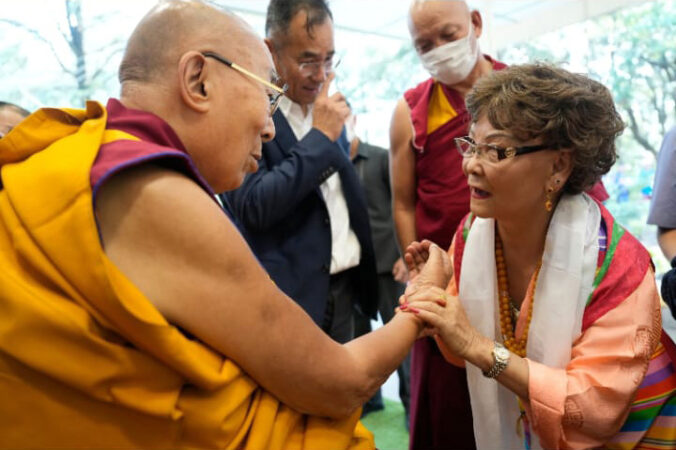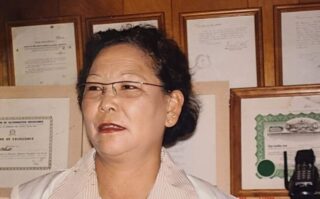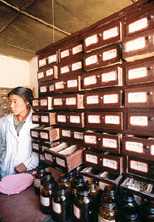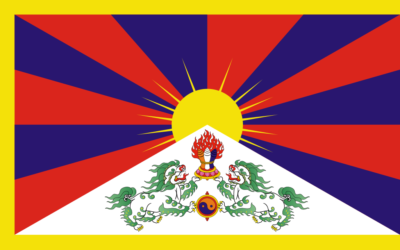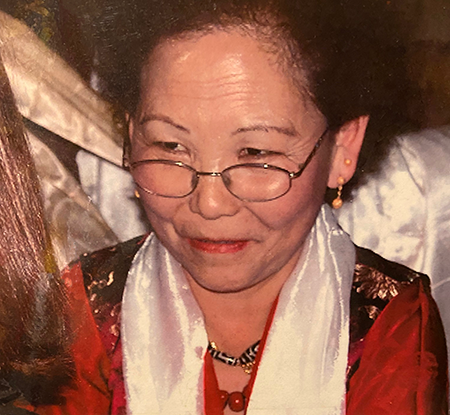Dr. Keyzom Bhutti is a doctor of Tibetan medicine with a practice in Somerville, Massachusetts. She was interviewed by Barbara Gerkes shortly after they attended the First International Conference on Tibetan Medicine in Washington, DC, November 7-9,1998.
Barbara Gerkess: Many people in the United States are very interested in Tibet and I’m sure they would like to hear a little about your life – how you were born in Tibet and how you came to India.
Keyzom Bhutti: I lived in the east of Tibet, the Sakya region. My family did farming, and my father was the head of the district. He was very smart and cared for the people – he took care of their welfare. I also had an uncle who was very important. He served directly under the Sakya Trizen who was head of the Sakya order. My uncle was his secretary.
Barbara: How old were you when you first came to India?
Keyzom: I was [ten]. With my father and mother, my younger sister and older brother, we all fled to India in 1959. [The Tibetan Uprising of March of that year elicited a violent response from Chinese troops, driving about 100,000 Tibetan refugees into northern India.] Right away I went to Central School for Tibetans there in Darjeeling. I continued up to the 10th year, then applied for the College of Tibetan Medicine in Dharamsala and was accepted. [Indian professional schools typically admit students directly from high schools.] I thought it would be good to serve people who are suffering from illnesses.
Barbara: What was the system for training the doctors at the College of Medicine?
Keyzom: At the medical college, I spent eight years all together – five years in classes and three years in practical training. These days they have reduced the number of years in the training and now I think it is only five years total.
Barbara: In your training you learned not only how to practice the medicine, but also how to make the medicine?
Keyzom: Yes, at the College I also learned how to make and prepare medicine. Tibetan doctors must know how to make the medicines – when to pick up the herbs, how to prepare them, how to mix them – everything we must know. I worked in the College pharmacy for three years. In the morning I went to practice with an experienced doctor, and in the afternoon I went to the pharmacy to learn how to prepare the medicine. Every year for one month we went to the mountains to learn how to recognize and gather the plants. We went to the Himalayas, to parts of Tibet, Bhutan, Sikkim, Kulu-Manali, also to places in the mountains closer to Dharamsala where the College is.
Barbara: When you went to the Medical College, who paid your expenses?
Keyzom: His Holiness the Dalai Lama, paid my expenses from his own pocket for three years. After those three years, the College found a sponsor for me from abroad.
Barbara: I understand you were in the very first class to graduate from the College of Medicine?
Keyzom: Yes I was in the first class. We were three women in the first batch, the rest were men. Altogether there were six of us. When we started there were fifteen of us. However, to study Tibetan medicine one needs special karma. Some of the students got sick due to the rough conditions in those days. Some got so sick they couldn’t attend the classes, so they couldn’t continue. Others became mentally disturbed due to studying the texts too hard, and some had accidents. Finally only six of us graduated. Fifteen started and six finished. At that time, life was very difficult. Following 1959, we refugees did not have a proper diet. We had many other difficulties, so many couldn’t continue to study. We had only one house. We all studied in the same room and we slept in the next room. We lived in just two rooms like that – one was for sleeping and one was for classes. We also had a kitchen. Now the College has a proper hostel and every facility is there. The students are given everything they need. It’s much easier these days, but previously we faced many difficulties.
Barbara: How did it come about that you returned to Darjeeling to practice medicine there?
Keyzom: After I graduated from the College, the head of the Department of Health [of the Tibetan government-in-exile] selected me to open a clinic in Darjeeling because at that time there was no Tibetan medicine at all in Darjeeling but there were many Tibetan refugees there. So I set up that clinic and worked there for 25 years.
Barbara: Was it very difficult when you first started that clinic in Darjeeling?
Keyzom: Yes, because I was the only Tibetan doctor there. Also it was very difficult to get a license to open the clinic, even though I had a degree from the Tibetan Medical College. At first it was very difficult to get patients because the local people – the Indians and Nepalese and even the Tibetans – didn’t know anything about Tibetan medicine. After a while, however, I was seeing fifty to sixty patients a day
Barbara: How was it that you came to the U.S.?
Keyzom: Primarily because the United States government was so kind to the Tibetan people. They gave an opportunity for 1,000 Tibetans to come and stay here, to immigrate. [The Tibetan Resettlement Act provided 1,000 resident visas for Tibetan refugees.] So my husband was one of those selected to come. But each family was given only one visa. So he came first, before me by six years, then this year I and our two children came and joined him here. Now we are very happy to be together again!
Barbara: What are the main differences between medicine here in the U.S. and India?
Keyzom: Here the patients are so serious! They are very careful with the supplements. In India, whatever medicine we gave to the patients they would just take it without noticing anything about the effects. They have complete faith in the doctors; whatever the doctor says, they will obey it. They are very happy to get the doctor’s advice, and they never complain. But here the patients look for the action of each of the tablets. Here, the patients are just as powerful as the doctors and the doctor has to be very careful how to treat them.
Barbara: What about life in general here in the U.S.? What is it like for you?
Keyzom: This is a very busy life, I seem to be very busy. Sometimes I would like to stay in a very calm place, but my mind never keeps calm and quiet. Whenever I look outside at all the things people are doing it makes me so busy in my mind. I find the people and the atmosphere are very busy so I cannot be very quiet within myself.
Barbara: What is the thing you like most about the U.S.?
Keyzom: I like the sanitation and the cleanliness. Everywhere the facilities are very good. Everybody has a right to speak what they want. You know – freedom – I like it!
Barbara: Do you think that as more amchis [the term for Tibetan doctors] come to the U.S. and start seeing American patients, that they’ll have to adapt their practice in any way? For instance, do you think the actual supplements have to be changed?
Keyzom: The same supplements are OK to use here, but the way of life and everything is very different from India so there will have to be some changes.
Barbara: What do you think about the problem of getting the supplements? Lately it’s very difficult to get Tibetan medicines even in India.
Keyzom: These days more and more doctors are making them in India. People in the United States are looking for alternative medicine, and we are getting very good results. But the supplements are difficult to get. We can’t get them from the College of Tibetan Medicine because they have to give so much to their own many doctors and clinics but in India many doctors said they are going to begin making the medicines on their own. In the future I think we’ll get the supplements without any difficulty. The College of Tibetan Medicine is looking for land to start herb farms. They are sending representatives to look for land in different parts of the Himalayas to accommodate the many plants needing different heights, different temperature and amount of rain to plant the medicines.
Barbara: Almost all the amchis are Tibetan. Do you think it is possible for Westerners to learn Tibetan medicine?
Keyzom: I think it’s very difficult to learn Tibetan medicine until one learns the Tibetan language. Once they learn to read the Tibetan texts and how to speak the language, then they can get a good background in Tibetan medicine and learn easily. Tibetans take five years of courses in the Medical College. On top of that how much longer will it take the Western students to learn the Tibetan language? But it’s necessary, because the medicine text [the Four Tantras] is not like an ordinary textbook. It is a very deep, like an ocean. You have to learn everything in detail. It’s not a very easy task.
Barbara: Who was your most important teacher for Tibetan Medicine?
Keyzom: My best teacher in everything was my guru was Pema Wangyal. He was a very learned person, a scholar. He knew astrology, he knew medicine, he knew how to prepare gold for use in some powdered medicines, he knew so many things.
Barbara: Can you explain a little bit what is the cause of health and what is the cause of illness from the Tibetan medicine point of view?
Keyzom: In our bodies we have the three Nyepa [“three troublemakers”]. We call them lung, triba and bankan. Lung is wind, triba is bile, and bankan is phlegm. If these three are in the balance, then the person has no disturbance, no illness. But if these three are imbalanced, then it disturbs the body and we get illness. The physician has to check whether these three Nyepa are in balance or not. We have to check each one.
Barbara: How do you check the three Nyepa?
Keyzom: We do it by reading the pulses. On each wrist we use three fingers. Each finger has two nerves, and each of these are connected with a different organ. So each finger can tell the balance of the Nyepa in two different organs. We can feel each different organ with our fingers, whether it is OK or not.
Barbara: Are there other methods of diagnosis?
Keyzom: We can also analyze the urine – the thickness of the urine and the kind of bubbles, sediment and color of the urine. From these we know whether the imbalance is wind or phlegm or bile. This also is a traditional method.
Barbara: What are the methods of treatment?
Keyzom: We have three kinds of treatment. First we advise the patient to correct the imbalance by changing their diet. Then we tell them to change their life style. Then also we give the herbal and mineral supplements. If all of these don’t restore the balance, then we will do moxibustion [smoldering a small cone of shredded herb on a special point on the surface of the body to heat it.]
Barbara: How many different kinds of medicine do you use?
Keyzom: At the College of Tibetan Medicine they used to make one hundred and fifty-five different medicines. Here I have about twenty-five different kinds right now, and I am hoping to get more from India. So we use different ones according to the imbalance of the person.
Barbara: Can you describe a little bit about Tibetan medical massage? What it is good for and what are the special oils you use?
Keyzom: We have one kind of massage which is very helpful to people who have depression. Another kind is very helpful to those who have a lack of heat in their body. The person who cannot stand up and cannot walk well, he needs a certain kind of massage that is very good for that illness. Some people have very rough skin, so they need a certain kind of massage. In general, massage is good for hypertension and relaxation and also to help memory. I like to use a special Tibetan oil. I ordered some from India and maybe I’ll get it in a few weeks. It is aged 8 years old. Then also I will mix certain herbs with that oil.
Barbara: What do you hope for your future here in the United States? What kind of life do you want to have five years from now?
Keyzom: I want to practice my medicine and contribute my knowledge to the United States. I would like to help especially people who are looking for alternative medicine. I’m looking for the patients who cannot find any effective medicine and I hope I can serve them. I want to work all my life like this.
Barbara Gerkes, originally trained as a nurse in Germany, is founder and director of the International Trust for Traditional Medicine in Kalimpong, India, where she organizes conferences and research projects on Ayurvedic and Tibetan medicine. Barbara also publishes the journal AyurVijnana. She can be contacted at:
Vijnana Niwas,
Madhuban, Kalimpong 734 301,
West Bengal, India.
Reprinted with permission from Spirit of Change Magazine, Jan/Feb 1999.
- Links to other interviews
- Living on Earth (NPR)
- Buddhist Door
- Spiritual.eu
- Tibet Elderly Help
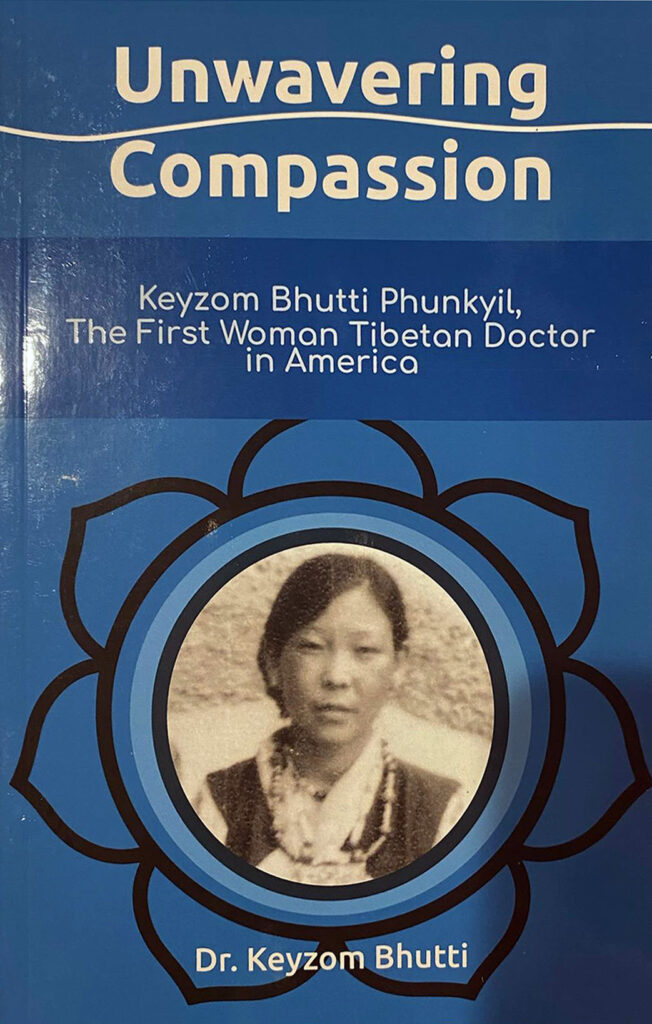
Keyzom Bhutti Phunkyil, The First Woman Tibetan Doctor in America

